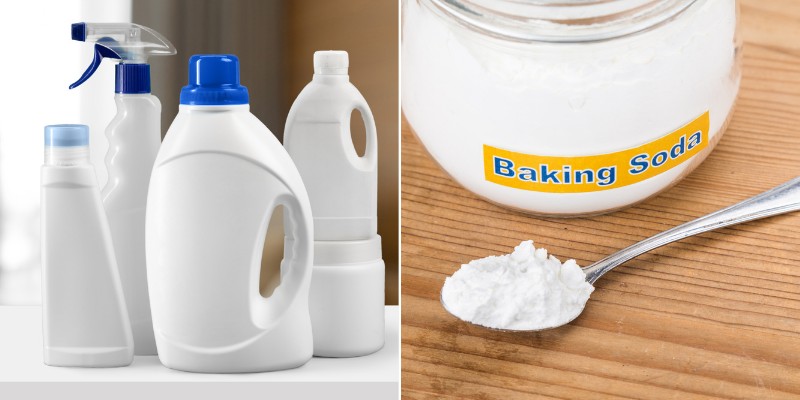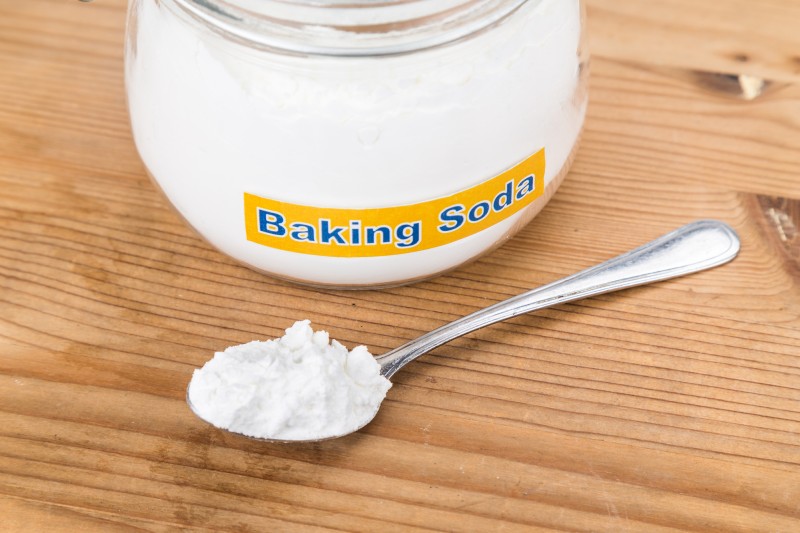For moms and dads whose kids suffer a variety of allergies, finding products that will keep their homes clean and sanitized while not impacting family member’s sensitivities can be a challenge.

But for those who understand that commodity products — like bleach and baking soda — can work as well as pricey brands of cleaners and disinfectants can help eliminate risk, these are ideal solutions.
From whitening fabrics to killing germs, these versatile and affordable products can be lifesavers alone or when used together.
Both bleach and baking soda have lots in common, say experts and both of these agents deliver extensive benefits, including refreshing laundry items, scrubbing appliances and serving as general cleaning aids for household tasks.
The latest generation of bleaches come in fragrances that cut the pungent aromas of ordinary bleach and because baking soda is an abrasive, you can make a paste of it and tackle your worst cleaning dilemmas.
In this article we’ll discuss a question and concern that many people have: “Can you mix bleach and baking soda for cleaning or other purposes?”.
Can you mix bleach and baking soda?
Yes, you can and in fact, baking soda holds the distinction of being the only cleaning product that is safe to mix with bleach, because unlike other cleaning liquids when mixed with baking soda, bleach won’t release toxic gasses that can cause reactions in anyone in the vicinity.
In concert, bleach and baking soda create an amazing agent to rid surfaces like walls and counters of deep dirt and even mold.
Protect yourself by wearing gloves, masks and glasses and ventilating the area when directions call for extra safety measures.
Here are some use cases of mixing bleach and baking soda:
1. Remove fabric stains and odors with bleach and/or baking soda
–Remove stains from white fabrics with bleach
Chlorine bleach alone will remove stains from white fabrics, writes Sarah Aguirre in her article for The Spruce.com.
Pour ½-cup of bleach into a washing machine’s bleach dispenser and load the washer as usual.
If there is no bleach dispenser, fill the tub with water and add the bleach but before the stained clothing goes in. If you need a remedy for an industrial-size load, make that 1 cup of bleach.
–Are garments smelly as well as stained? Try baking soda solo
Baking soda does an amazing job of vanquishing odors so whether garments just smell or they’re stained too, fill your washing machine with water, add laundry soap and clothes.

Toss in ½-cup of baking soda and let the magic begin. If a stain is particularly bad, you can pre-treat it before washing the garment by making a thick soda/water paste, rubbing it into the stain. Allow it to soak in and wash with plain water to get rid of all of the paste.
-Pair the two for best results
Mix ½-cup each of baking soda and bleach and add them to the wash water before you throw white items into the machine. This dynamic duo can make your wash look and smell divine.
2. Remove mold from walls with bleach and/or baking soda
–Try the baking soda/white vinegar solution
Nothing’s more disheartening than realizing that a dark wall stain is the result of a mold invasion requiring immediate attention.
Pair baking soda with white vinegar to stop the spread. Dissolve at least 2 teaspoons of baking soda in distilled white vinegar to spray consistency and saturate the moldy wall section.
Allow the spray to penetrate for between 5 and 10 minutes and then scrub the area with a damp cloth.
–Battle mold using bleach
Gear-up for your cleaning session by donning rubber gloves, goggles and a face mask because you will be dealing with both mold and bleach.
Dilute 1 cup of bleach into 1 gallon of tap water. Fill a spray bottle and saturate the wall, allowing the mix to penetrate for several minutes before wiping the area with a sponge or cloth. You did remember to open your windows and doors before you started, right?
–Blend a paste of bleach and baking soda
Since you run the risk of this mix in liquid form dribbling down the wall before it does its work, a paste is a more reliable solution – once you don those safety protections: gloves, mask, goggles and ventilate the room.
Place baking soda into a glass bowl and add just enough chlorine bleach to make a thick paste.
Apply with a toothbrush or other cleaning tool and then close the door for 24 hours, making sure nobody enters. Dressed in your gear, wash off areas where the paste has penetrated on the following day.
3. Clean your bathtub using bleach and/or baking soda
–Basic bleach and water treatment
Remove everything from the tub so nothing is exposed to bleach, rinse out the tub with hot water and wipe it down with a sponge to pre-loosen external grime.
Mix ½-cup bleach with 1 gallon of water and thoroughly detail the tub’s interior using a sponge. Allow the bleach to do its thing for at least 5 minutes and then rinse the tub using the sponge followed by towel drying.
–Tackle those stains with a baking soda/bleach paste
Time to put together best friends bleach and baking soda to double down on the grime removal.
Mix equal parts of bleach and baking soda to a pasty consistence and apply with a sponge or toothbrush. Allow the paste to penetrate the dirt and after 15 minutes, use a spray bottle filled with hot water and a damp sponge to wipe up the paste residue. Towel dry the area to finish the job.
-Enlist the jets to clean the tub with bleach
If the manufacturer of your sophisticated tub doesn’t recommend a specific cleaning regimen, you can fill the tub with water and as the interior fills, add ½ cup of liquid dish soap and between 2 and 4 cups of chlorine bleach.
The amount of bleach you use is a judgment call based on how imbedded the tub’s grime happens to be.
Set the water temperature to at least 140° Fahrenheit (60° Celsius) and run the jets for 20 minutes.
If your jets aren’t power-driven by heating mechanisms, substitute boiled water. Drain the tub after 20 minutes. Re-fill the tub with warm water and re-activate the jets for another 20 minutes to finish the process.
–Eliminate the bleach and use baking soda and vinegar instead
Mix 4 cups of hot water and 1 cup of distilled cleaning vinegar and use a soft brush or rag to meticulously detail the tub’s interior making sure to wear gloves to go about this labor-intensive tub cleaning method.
Once you’ve covered the expanse with the mix and removed all the grime, rinse the tub thoroughly with hot water to get rid of the residue left behind by the mix.
4. Clean grout between tiles using bleach and/or baking soda
–Use both bleach and baking soda to clean up grout
Gear up wearing rubber gloves, face protection and safety glasses before you mix ¾-cup of baking soda with ¼-cup of bleach to make a thick paste.
Use a stiff brush or another abrasive tool to attack all of the dingy-looking grout lines and give the mixture at least 10 minutes to cure so the bleach tackles the grout.
Go over all of the areas with your brush (toothbrushes are the best). Don’t rinse. Let the paste keep working for another 10 minutes or so. Use the shower spray or a spray bottle to remove all of the grime and paste.
–Clean your grout with oxygen bleach powder and water
Since you’ll be using the powdered form of bleach, you can make a paste without including baking soda.
Use water to slightly dilute the powder so it reaches the consistency of toothpaste (Start with 2 parts powdered bleach to 1 part water).
Use the edge of a sponge to apply the paste and allow it to soak in for up to 10 minutes.
Use a stiff brush to scrub the area and then rinse with clear water to remove the residue.
–Clean your grout with chlorine bleach alone
Ventilate the area and don rubber gloves and safety glasses. Dip a small grout brush into the unadulterated bleach and scrub areas meticulously and thoroughly.
Use a sponge with clear water to neutralize the areas. If you aren’t satisfied with the results, you can repeat the process. Wipe all surfaces down with a dry towel.
What you Can and Can’t Mix Together
Your safety primer
- -Never mix bleach with toilet bowl cleaner
- -Don’t mix any type of bleach with rust removal products
- -Citrus juices (lime or lemon) shouldn’t be paired with bleach for clean ups
- -Avoid mixing ammonia with bleach or you’ll create a dangerous liquid
- -You can always mix bleach with plain water to undertake cleaning jobs
- -As you already know, bleach works nicely with most laundry detergents
- -Don’t mix bleach with vinegar or you could produce toxic chlorine gas
- -Rubbing alcohol and bleach are toxic when combined, too
- -If you mix vinegar with baking soda, you’re not going to get the results you seek. The two neutralize each other and you lose the benefits of both!
Related Posts
- How to Stop Sliding Doors from Rattling – Causes and Solutions
- Cheap Ways to Heat a Room – Efficient and Budget-Friendly Solutions
- 11 Ways to Get Rid of Cooking Smells in a Small Apartment or House
- 11 Stores and Sites Like IKEA For Affordable Furniture and Home Products
- All About Polypropylene – Olefin Fabric Sofa Material
- 12 Different Types of Wood for Outdoor Furniture with Pros/Cons
Leave a Reply